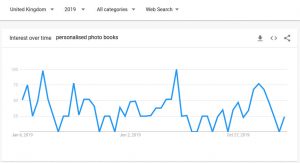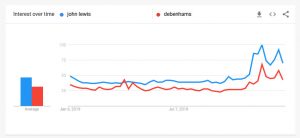If you ever check your web traffic and sales, you will most likely notice that performance fluctuates in annual cycles. Demand will often see peaks and dips depending on periods in the year and what sector your business is in.
In many cases this is quite obvious; if you’re an e-commerce retailer there will be an increase in traffic in the run up to Christmas, whilst if you’re selling Summer holidays, this will start growing in the New Year. However, as well as big holidays there are often a lot of opportunities throughout the year that may not initially be obvious.
Knowing how your business reacts to different periods is key to planning out a good marketing strategy and taking advantage of changes in user behaviour to help build on your own marketing efforts.
There is lots of benefits to having a strong seasonal marketing approach. It can help to:
- Put your brand and business in front of audiences they may not have originally reached
- Create a strong, relevant presence
- Capitalise on uplifts in search activity
- Minimise wasted marketing spend and efforts during downturns
- Take advantage of current events and reacting accordingly, showing your relevancy and awareness to customers and prospects
Understanding what these are and how to plan your marketing around this can help to build a strong platform to drive more engaged users to your site.
What is Seasonal Marketing?
Quite simply, Seasonal Marketing is adjusting your marketing activity to ongoing events and periods in the year. This can cover things like national holidays and the impact this will have on your user behaviour, or bigger elements like the build up to a specific event or period.
The key areas to look at for this are:
- How your product or service fits within the year
- Are there different periods in the year when demand increases or decreases?
- How your users plan out their buying journey
- How long or short is the buying cycle?
- Can you plan activity to take advantage of this research period and the different time it takes place?
- What external factors are relevant in your user market?
- Are there local/national holidays that can impact behaviour?
- Are there periods that people expect online behaviour to change?
Understanding and planning against external factors is one of the key areas to focus on when planning out your seasonal marketing. The advantage of this is that these events are already pre-planned and pre-determined and can be used to your marketing advantage to help send extra traffic to your business.
As recently as 10 years ago, very few in the UK had even heard of Black Friday. However, in recent years it started gaining some traction and now there is a whole Seasonal approach dedicated to marketing activity in November to cater for this. Consumers have started to expect offers and activity from Businesses, which has led to increased search volume and web visits as they see what is available, and consumers have started to plan their shopping activity around this; reducing their e-commerce sales in the weeks leading up to Black Friday in the hope that they’ll be able to take advantage of discounts during the period itself.
So where do I start?
It is best to start building up an annual marketing schedule, populating this with all the different areas that you can think of. Key elements to look at would be:
- Product/Service release dates
- Existing marketing activity
- Key events: Summer/Christmas, Local holidays
- Industry events & dates: e.g. Tradeshows, Brochure drops, Industry deadlines and product seasonality
- Competitor activity (where possible)
If you have been in business for a while, you should already have a good understanding of what your current seasonality looks like. Try and plan out when people start researching and buying. Incorporate any local/national holidays. It is also very important to plot out key dates for your industry. if you are offering Financial advice, then the Tax year dates would be key.
If you have Google Analytics installed, then look back over the past few years to see when traffic and sales/conversions increase on your site. This information should help provide an indication of what your seasonality looks like and you can plan this out accordingly. Make sure you check year-on-year trends to see how the trends have changed. You can also use any other data you have access to, such as Google AdWords or Facebook page manager to see how traffic and interaction has performed over the years and any search spikes that have come up.
Utilising External Data
There is a wealth of resources available that can show help identify seasonal trends for your industry. One of the biggest is Google Trends which can show search trends for specific keywords to categories for a tailored date range. Looking at how your industry terms do throughout the year can help you to plan out activity.
If we look at a term such as Personalised Photo Books. We can see the expected upward trend between October and December as people buy these for Christmas gifts. However, there is also a spike up in July and August which would not normally be expected. This could be people looking for a Post-Holiday memory book, and as such, could be an opportunity to push this tactically.

One advantage of Google Trends is that it allows any keyword to be searched for, which can include both your brand and your competitors. This is really useful to see how both their search trends match or differ against yours, but also how much of a difference in brand recognition there is:

Looking at 2019 data for John Lewis and Debenhams, they both follow roughly the same trends, but differ slightly in that Debenhams has some negative publicity in Spring, whereas John Lewis sees their Christmas trend start sooner; often as a result of their TV ad launching.
Checking this data will help to build up a profile on where to start planning which key dates to plan activity for, and also if there is likely to be any demand for this; If you search for a key term and see minimal search volume, then there may be little benefit in actually planning activity for this time.
Another area to focus on is looking at what your competitors are doing. Sign up to their newsletters, order copies of their brochures and keep an eye on their website and social media to understand what they are doing and planning as well as the messaging and offers they are using. Knowing this can help to influence your seasonal activity if you see that there is already demand for your products and services.
How do I plan this out?
Once you have identified what your key periods should be, then map this out onto a chart to know when they should be planned out. Knowing the dates in advance means that you can plan out and prepare all the launch phases so that they are ready to launch on the date, rather than rushing to complete these.
One of the best models for running seasonal activity is to incorporate a mix of the Evergreen/Amplify approach: Maintaining a continuous presence but then pushing activity during the key period, as in the following model
To get the best performance out of this, tactical marketing activity should be approached with the following model which helps to ensure a maximise return:

- Evergreen
- This is the ongoing business-as-usual marketing activity, Paid search, email marketing etc. Whereby you continually remind your audience of your offering
- Prime
- In advance of the seasonal spike, start building up your marketing efforts.
- This could be adjusting your evergreen copy with messaging about the upcoming sale period, or soft launching your seasonal campaign
- Amplify Peak
- This is the core period of search demand: Fully launch your seasonal activity with tailored messaging and relevant keywords. Adjust budgets to have a strong presence and fully take advantage of the spike in demand
- Amplify Evergreen
- During this time, Try launching tactical activity on your Evergreen activity; this could be a sitelink on your campaign, or even 1 or 2 tactical ad copies promoting the offer. With users looking for other products and services from your business there is an opportunity to push the seasonal activity
- Remind
- Once the spike has ended there is still an opportunity to build on this
- Anyone unconverted could be remarketed if they are still searching for your products, or there may be an option to cross-sell other products to converted users
- You can also utilize other marketing activity, such as newsletters or content marketing, to keep your business fresh in the minds of people who may yet convert
Whilst not all seasonal activity will need to go to the lengths of having the Evergreen/Amplify approach, it is worth keeping this model in mind when planning big spikes.
What activity should I do?
Once you know what seasonal areas you want to focus, there are a lot of different options available that you can utilize to promote the activity. There are no right or wrong answers for what to use, but you should consider how much budget you have available, how much resource you need to plan this, as well as how much potential volume you have. An e-commerce site should utilize a lot more planning and activity for their Christmas campaign compared to just having a giveaway for a single store.
Some of the options to consider are:
- Newsletters
- One of the best ways to get the word out on a seasonal offer is to send out a newsletter to your database. These users are already engaged with your business, so a reminder to them of any new offering can be a very quick and even free way to promote anything
- Site Content
- If you have a blog or regularly update your site, try adding some tactical content around the seasonal offering. Perhaps offer Christmas buying guides, or Summer planning; Anything that integrates to the buying cycle and you can link back to your products and services.
- Once you have the content on your site, this can be promoted through Social media and your newsletters to spread this to a wider audience
- Display Activity
- If your business serves a niche area, then running banner advertising promoting your offer on relevant websites will help to attract an engaged audience and get a lot of brand awareness
- Social Media
- Try posting about any upcoming sales on your Social media. This can link to the products or the new content to try and attract users to the site
- You could also offer promotions through Social media, such as discounts for registration to try and build up a profile during the seasonal period
- PPC: Tactical Campaigns
- If there is enough demand then launching Paid search on relevant, tactical & seasonal keywords can help to build up awareness and drive traffic to the site for terms that otherwise may not have worked
- One thing to factor in when running anything Tactical is to carefully consider how much competition there is and adjust the targeting accordingly: If you sell Electronics then it would be very expensive to bid on “Black Friday Electronics Offers” across the UK as this would compete against Amazon and Blue-chip e-tailers. However, you could try to target only a specific audience or geographic market to try and gain some presence in a relevant market
- PPC: Tactical Ads & Extensions
- The key way to get your message across is to ensure that your Ads promote what you are offering. By running tactical ads and extensions you can easily mention what the offer is, any discounts or prices, start/end dates, and link through to the best landing page.
- Try testing a couple of variations to see what gets the best interaction and then use these findings for future activity
- Explore all available extensions within Google AdWords to see what works: You could run a sitelink to the sale page, or a Promotion extension promoting “Up to 20% off till xx/xx/xx” to help build up visibility and drive traffic and sales
Once you have determined what tactics to run with, ensure these are planned out with a consistent message across channels. Make sure the offer is valid for the audience and targeting the right people and they all follow your brand guidelines. You want to ensure that you can keep your existing user base engaged, whilst also appealing to your potential new customers.
Try and see what your customers are mentioning when they are running Seasonal activity: Are they promoting a discount or offer. If so, can you use this opportunity to try and match this or differentiate yourself from this If not then you should diversify and look at focusing on a different area that may perform better.
After running the campaign, do not forget to utilize the Remind phase and reach out to your users. This could be to try and convert them, or to promote the next seasonal phase. Keeping these users engaged will help to build up your brand over time, and make future marketing efforts a more simplified process
In Summary
When planning out your seasonal marketing strategy you should be aware of your internal factors, but more importantly, look at all available external factors and use these to your advantage. Look at what the search demands are for your business; both researching and purchasing, to ensure you are aligned with the key periods. Monitor what your competitors are doing to understand any opportunities or threats that they present, and do not forget to plan out and test your approach across the relevant channels.
Having a robust strategy in place that works will help make your future marketing efforts easier; knowing what has been tested and what has performed, and what dates you should concentrate your efforts against.
If you would like any support on planning out your Seasonal marketing, then why not get in touch today to discuss your efforts with one of our specialists and see how Shrpa can help.

